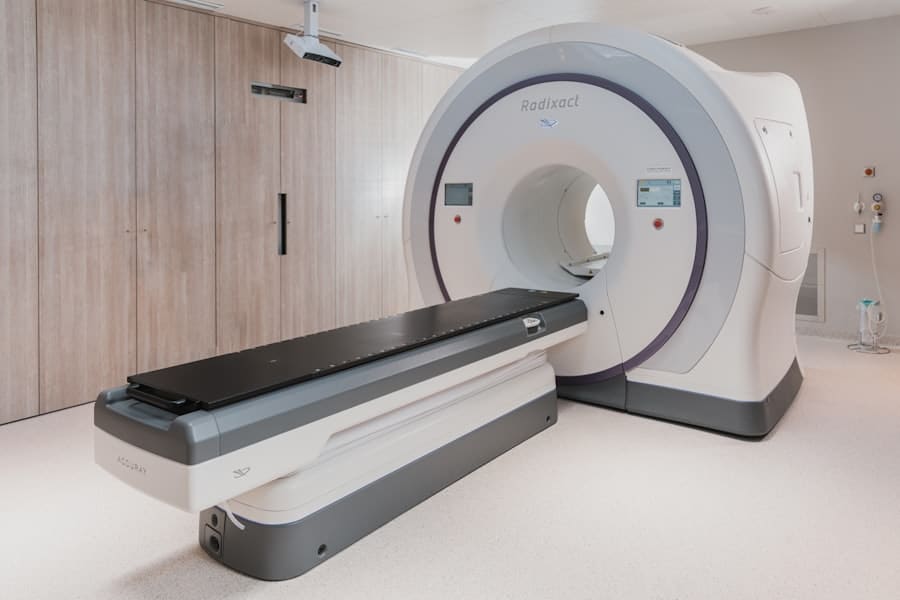The advent of advanced medical imaging software has significantly transformed the landscape of healthcare, enhancing diagnostic accuracy and treatment efficacy. This technology encompasses a range of modalities, including MRI, CT scans, and ultrasound, which are now augmented by sophisticated software solutions that facilitate image acquisition, processing, and analysis. The integration of these advanced tools into clinical practice has not only improved the visualization of anatomical structures but has also enabled healthcare professionals to detect diseases at earlier stages, ultimately leading to better patient outcomes.
Moreover, the impact of advanced medical imaging software extends beyond individual patient care; it also influences healthcare systems at large. By streamlining workflows and reducing the time required for image interpretation, these technologies contribute to increased operational efficiency within healthcare facilities. This efficiency is particularly crucial in emergency settings where timely diagnosis can be the difference between life and death.
As healthcare continues to evolve, the role of advanced medical imaging software will only become more pronounced, underscoring its relevance in modern medical practice.
Key Takeaways
- Advanced medical imaging software has a significant impact on healthcare by improving diagnostic accuracy, treatment planning, and patient outcomes.
- The use of advanced medical imaging software is changing the way diseases are diagnosed and treated, leading to more personalized and effective care for patients.
- Artificial intelligence is playing a crucial role in revolutionizing medical imaging by enabling faster and more accurate analysis of medical images.
- Advancements in 3D and 4D medical imaging technology are enhancing the visualization and understanding of complex anatomical structures and physiological processes.
- The integration of advanced medical imaging software in surgical planning and intervention is improving the precision and safety of surgical procedures, leading to better outcomes for patients.
How Advanced Medical Imaging Software is Changing the Diagnosis and Treatment of Diseases
Advanced medical imaging software is revolutionizing the way diseases are diagnosed and treated by providing clinicians with enhanced tools for analysis and interpretation. For instance, software that utilizes machine learning algorithms can analyze vast datasets of imaging studies to identify patterns that may be indicative of specific conditions. This capability not only aids in the early detection of diseases such as cancer but also allows for more personalized treatment plans tailored to the unique characteristics of each patient’s condition.
In addition to improving diagnostic accuracy, advanced imaging software facilitates real-time monitoring of disease progression and treatment response. For example, oncologists can utilize imaging software to assess tumor size and metabolic activity over time, enabling them to adjust treatment protocols based on the patient’s response. This dynamic approach to treatment underscores the importance of integrating advanced imaging technologies into clinical workflows, as it empowers healthcare providers to make informed decisions that enhance patient care.
The Role of Artificial Intelligence in Revolutionizing Medical Imaging

Artificial intelligence (AI) is at the forefront of the revolution in medical imaging, offering unprecedented capabilities in image analysis and interpretation. AI algorithms can process images with remarkable speed and accuracy, identifying abnormalities that may be missed by the human eye. This technology not only enhances diagnostic precision but also alleviates some of the burdens faced by radiologists, allowing them to focus on more complex cases that require human expertise.
Furthermore, AI-driven imaging software can continuously learn from new data, improving its performance over time. This adaptability is particularly beneficial in a field where new diseases and conditions emerge regularly. For instance, during the COVID-19 pandemic, AI tools were rapidly developed to assist in the detection of pneumonia associated with the virus through chest X-rays and CT scans.
Such innovations highlight AI’s potential to respond swiftly to public health challenges while reinforcing its role as a critical component of advanced medical imaging software. (Source: NCBI)
Advancements in 3D and 4D Medical Imaging Technology
| Advancements | 3D Medical Imaging | 4D Medical Imaging |
|---|---|---|
| Improved Resolution | Higher resolution images for better diagnosis | Real-time imaging of moving organs and structures |
| Enhanced Visualization | Clearer visualization of anatomical structures | Visualization of dynamic processes in real-time |
| Reduced Radiation Exposure | Lower radiation doses for patients | Reduced need for repeated scans |
| Improved Image Processing | Advanced algorithms for image reconstruction | Real-time data processing for dynamic imaging |
The evolution of 3D and 4D medical imaging technology has opened new frontiers in visualization and analysis, providing clinicians with a more comprehensive understanding of complex anatomical structures. 3D imaging allows for the reconstruction of images from multiple angles, enabling healthcare providers to view organs and tissues in a more lifelike manner. This enhanced visualization is particularly beneficial in surgical planning, as it allows surgeons to anticipate challenges and devise strategies before entering the operating room.
4D imaging takes this a step further by incorporating the element of time into the visualization process. This dynamic approach enables clinicians to observe physiological processes in real-time, such as blood flow or organ movement during respiration. The ability to visualize these processes enhances diagnostic capabilities and informs treatment decisions, particularly in fields such as cardiology and oncology.
As technology continues to advance, the integration of 3D and 4D imaging into routine clinical practice will likely become standard, further enriching patient care.
The Integration of Advanced Medical Imaging Software in Surgical Planning and Intervention
The integration of advanced medical imaging software into surgical planning has revolutionized how procedures are conducted, enhancing both safety and efficacy. Preoperative imaging allows surgeons to visualize the surgical site in detail, facilitating better planning and execution. For instance, using 3D reconstructions from CT or MRI scans, surgeons can create precise models of complex anatomical structures, which can be used for simulation training or intraoperative navigation.
Intraoperatively, advanced imaging software can provide real-time guidance during procedures, allowing surgeons to make informed decisions based on live data. This capability is particularly valuable in minimally invasive surgeries where precision is paramount. By leveraging advanced imaging technologies, surgical teams can reduce complications and improve patient outcomes, ultimately leading to shorter recovery times and enhanced quality of life for patients.
Improving Patient Care and Outcomes with Advanced Medical Imaging Software

The ultimate goal of advanced medical imaging software is to improve patient care and outcomes through enhanced diagnostic capabilities and treatment planning. By providing clinicians with detailed insights into a patient’s condition, these technologies enable more accurate diagnoses and tailored treatment strategies. For example, advanced imaging techniques can help identify subtle changes in disease progression that may not be visible through traditional methods, allowing for timely interventions that can significantly alter a patient’s prognosis.
Moreover, patient engagement is enhanced through advanced imaging technologies that facilitate better communication between healthcare providers and patients. Visual aids derived from advanced imaging can help patients understand their conditions more clearly, fostering a collaborative approach to care. When patients are well-informed about their health status and treatment options, they are more likely to adhere to prescribed therapies and participate actively in their care journey.
Overcoming Challenges and Limitations in the Implementation of Advanced Medical Imaging Software
Despite the numerous benefits associated with advanced medical imaging software, several challenges must be addressed for successful implementation within healthcare settings. One significant barrier is the high cost associated with acquiring and maintaining advanced imaging technologies. Many healthcare facilities may struggle to justify these expenses, particularly smaller practices or those operating under tight budgets.
Additionally, there are concerns regarding interoperability between different imaging systems and electronic health records (EHRs). Ensuring seamless integration is crucial for maximizing the utility of advanced imaging software; however, varying standards across platforms can complicate this process. To overcome these challenges, healthcare organizations must prioritize strategic planning and investment in training for staff members who will be utilizing these technologies.
The Future of Healthcare with Advanced Medical Imaging Software
Looking ahead, the future of healthcare will undoubtedly be shaped by continued advancements in medical imaging software. Emerging technologies such as augmented reality (AR) and virtual reality (VR) are poised to further enhance visualization capabilities, providing immersive experiences that can aid in both diagnosis and surgical training. These innovations will likely lead to even greater precision in treatment planning and execution.
Moreover, as AI continues to evolve, we can expect even more sophisticated algorithms capable of analyzing complex datasets with minimal human intervention. This shift will not only improve diagnostic accuracy but also enable predictive analytics that can inform proactive healthcare strategies. As we embrace these advancements, it is essential for healthcare professionals to remain adaptable and open to integrating new technologies into their practice.
In conclusion, advanced medical imaging software represents a pivotal advancement in healthcare that enhances diagnostic capabilities, improves patient outcomes, and streamlines clinical workflows. By understanding its impact on diagnosis and treatment, recognizing the role of AI and emerging technologies, and addressing implementation challenges, healthcare professionals can harness the full potential of these innovations. As we move forward into an era defined by technological advancement, it is imperative for IT decision-makers and healthcare providers alike to prioritize investment in advanced medical imaging solutions that will shape the future of patient care.
If you are interested in learning more about the benefits of utilizing Medical Imaging Software, you may want to check out this article on Tech Rockstars website. This article discusses how IT companies in La Puente are leveraging advanced technology to improve medical imaging processes and enhance patient care. By implementing cutting-edge software solutions, healthcare providers can streamline their operations and deliver more accurate diagnoses.
FAQs
What is medical imaging software?
Medical imaging software is a type of computer program used by healthcare professionals to view, analyze, and manipulate medical images such as X-rays, CT scans, MRIs, and ultrasounds.
What are the common features of medical imaging software?
Common features of medical imaging software include image viewing, image manipulation (such as zooming and rotating), measurement tools, annotation tools, 3D reconstruction, and image sharing capabilities.
How is medical imaging software used in healthcare?
Medical imaging software is used by healthcare professionals to diagnose and monitor various medical conditions, plan and guide surgical procedures, and track the progress of treatment.
What are the benefits of using medical imaging software?
The benefits of using medical imaging software include improved accuracy and efficiency in diagnosis, better visualization of anatomical structures, enhanced communication between healthcare professionals, and reduced need for physical storage of medical images.
Is medical imaging software regulated?
Yes, medical imaging software is regulated by government agencies such as the Food and Drug Administration (FDA) in the United States to ensure its safety and effectiveness for clinical use.
What are some examples of medical imaging software?
Examples of medical imaging software include PACS (Picture Archiving and Communication System) software, 3D medical imaging software, and specialized software for specific imaging modalities such as MRI or CT scans.


